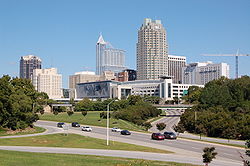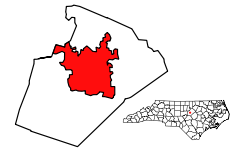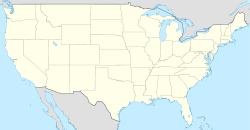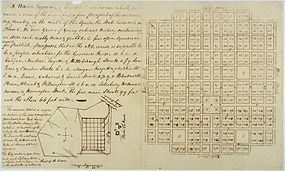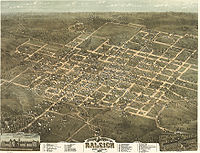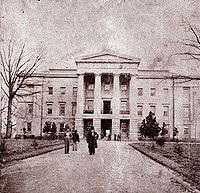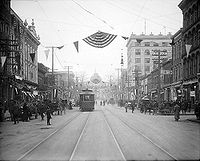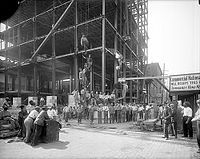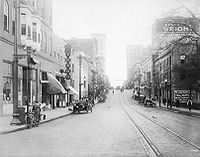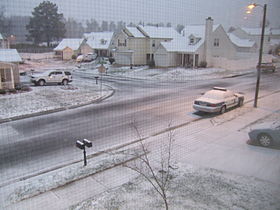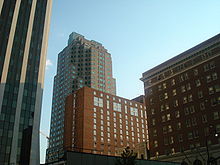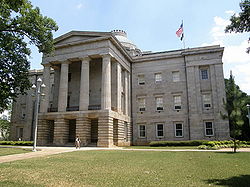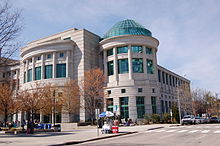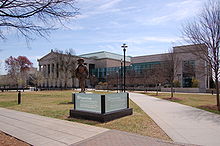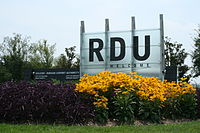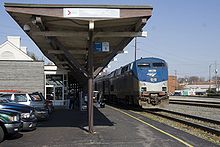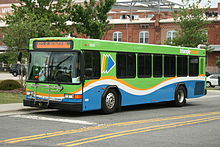- Raleigh, North Carolina
-
For other uses of this name, see Raleigh.
Raleigh — State Capital — City of Raleigh 
Flag
SealNickname(s): "City of Oaks" Map of Wake County, North Carolina Location in the United States Coordinates: 35°49′8″N 78°38′41″W / 35.81889°N 78.64472°WCoordinates: 35°49′8″N 78°38′41″W / 35.81889°N 78.64472°W Country United States of America State North Carolina Counties Wake, Durham Founded 1792 Government – Mayor Nancy McFarlane (D) Area – Total 144.8 sq mi (375 km2) – Land 142.8 sq mi (369 km2) – Water 2.0 sq mi (2.5 km2) Elevation 315 ft (96 m) Population (Census 2010)[1][2] – Total 403,892 (43rd) – Density 2,826.3/sq mi (1,097.17/km2) – MSA 1,130,490 – CSA 1,749,525 Time zone Eastern (EST) (UTC-5) – Summer (DST) EDT (UTC-4) Area code(s) 919, 984 FIPS code 37-55000[3] GNIS feature ID 1024242[4] Website www.raleighnc.gov Raleigh (pronounced /ˈrɔːli/, rall-lee[5]) is the capital and the second largest city in the state of North Carolina as well as the seat of Wake County. Raleigh is known as the "City of Oaks" for its many oak trees.[6] According to the U.S. Census Bureau, the city's 2010 population was 403,892, over an area of 142.8 square miles (370 km2), making Raleigh currently the 43rd largest city in the United States. It is also one of the fastest growing cities in the country.[1][7] The city of Raleigh is named after Sir Walter Raleigh.
Raleigh, Durham, and Chapel Hill make up the three primary cities of the Research Triangle metropolitan region. The regional nickname of "The Triangle" originated after the 1959 creation of the Research Triangle Park, primarily located in Durham County, four miles from downtown Durham. RTP is bordered on three sides by the city of Durham and is roughly midway between the cities of Raleigh and Chapel Hill, and three major research universities of NC State University, Duke University, and UNC-Chapel Hill.
Effective June 6, 2003 the U.S. Office of Management and Budget redefined the Federal Statistical Areas and dismantled what had been for decades the Raleigh-Durham-Chapel Hill, MSA and split them into two separate MSAs, even though the region still functions as a single metropolitan area. This resulted in the formation of the Raleigh-Cary, NC MSA and the Durham-Chapel Hill, NC MSA.
The Research Triangle region encompasses the U.S. Census Bureau's Combined Statistical Area (CSA) of Raleigh-Durham-Cary in the central Piedmont region of North Carolina. As of Census 2010 the population of the Raleigh-Durham-Cary CSA was 1,749,525. The Raleigh-Cary Metropolitan Statistical Area (MSA) as of Census 2010 was 1,130,490.
Most of Raleigh is located within Wake County, with a very small portion extending into Durham County.[8] The towns of Cary, Morrisville, Garner, Clayton, Wake Forest, Apex, Holly Springs, Fuquay-Varina, Knightdale, Wendell, Zebulon, and Rolesville are some of Raleigh's primary nearby suburbs and satellite towns.
Contents
History
18th century
In December 1770, Joel Lane successfully petitioned the North Carolina General Assembly to create a new county. On January 5, 1771, the bill creating Wake County was passed in the General Assembly, resulting in the formation of Wake County. The county was formed from portions of Cumberland, Orange, and Johnston counties. the county gets its name from Margaret Wake Tryon, the wife of Governor William Tryon. The first county seat was Bloomsbury.
New Bern a port city, is only 35 miles from the Atlantic Ocean was the largest city and the original capital of North Carolina during the American Revolution. With the British Army laying siege to New Bern, North Carolina’s government could not take place within there so relocation was necessary. Raleigh was chosen as the site of a new state capital in 1788 since its location was near the center of the state. Officially established in 1792 as both county seat and state capital, the city was named for Sir Walter Raleigh, sponsor of the Colony of Roanoke. The "Lost Colony" is commemorated at the Fort Raleigh National Historic Site on Roanoke Island, North Carolina.
The city's location was chosen, in part, for being within 11 miles (16 km) of Isaac Hunter's Tavern, a popular tavern frequented by the state legislators. No known city or town existed previously on the chosen city site. Raleigh is one of the few cities in the United States that was planned and built specifically to serve as a state capital. Its original boundaries were formed by the downtown streets of North, East, West and South streets. It was planned to be laid out in an axial fashion, with four public squares and one central square.[9]
The North Carolina General Assembly first met in Raleigh in December 1794, and quickly granted the city a charter, with a board of seven appointed commissioners (elected by the city after 1803) and an "Intendant of Police" (which would eventually become the office of Mayor) to govern it. In 1799, the N.C. Minerva and Raleigh Advertiser became the first newspaper published in Raleigh. [10] John Haywood was the first Intendant of Police.[11] Raleigh's Historic Oakwood contains many houses from the 19th century that are still in good condition.
19th century
In 1808 Andrew Johnson, the nation’s seventeenth President, was born at Casso’s Inn in Raleigh. The city's first water supply network was completed in 1818, although due to system failures the project was abandoned. 1819 saw the arrival of Raleigh's first volunteer fire company, followed in 1821 by a full-time fire company.
In 1831, a fire destroyed the State Capitol. Reconstruction began two years later with quarried granite being delivered by the first railroad in the state. Raleigh celebrated the completions of the new Capitol and new Raleigh & Gaston Railroad Company in 1840.
In 1853, the first State Fair was held near Raleigh.
The first institution of higher learning in Raleigh, Peace College, was established in 1857.
After the Civil War began, Governor Zebulon Baird Vance ordered the construction of breastworks around the city as protection from Union troops. During General Sherman's Carolinas Campaign, Raleigh was captured by Union cavalry under the command of General Hugh Judson Kilpatrick on April 13, 1865. After the Confederate cavalry retreated west, the Union soldiers followed, leading to the nearby Battle of Morrisville.[12] The city was spared significant destruction during the War, but due to the economic problems of the post-war period and Reconstruction, it grew little over the next several decades.
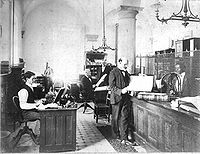 North Carolina State Treasurers Office in State Capitol, c 1890s
North Carolina State Treasurers Office in State Capitol, c 1890s
After the Civil War ended in 1865, African Americans were able to be educated and men could become involved in politics. With the help of the Freedmen's Bureau, many freedmen migrated from rural areas to Raleigh. Shaw University, the South's first African-American college, began classes in 1865 and was chartered in 1875. Shaw's Estey Hall was the first building constructed for the higher education of black women, and Leonard Medical Center was the first four-year medical school in the country for African Americans.
In 1867, Episcopal clergy founded St. Augustine's College for the education of freedmen. In 1869, the state legislature approved the nation’s first school for blind and deaf African Americans to be located in Raleigh. And in 1874, the city's Federal Building was constructed in Raleigh, the first federal government project in the South following the Civil War.
In 1880, the newspapers News and Observer combined to form The News & Observer. It remains Raleigh's primary daily newspaper. The North Carolina College of Agriculture and Mechanic Arts, now known as North Carolina State University, was founded as a land-grant college in 1887. The city's Rex Hospital opened in 1889 and housed the state's first nursing school. The Baptist Women's College, now known as Meredith College, opened in 1891, and in 1898, The Academy of Music private music conservatory was established.
In 1900, the state legislature passed a new constitution, with voter registration rules that disenfranchised most blacks and many poor whites. Added to earlier statutory restrictions, the state succeeded in reducing black voting to zero by 1908. It was not until 1965 that the majority of blacks in North Carolina would again be able to vote, sit on juries and serve in local offices.
20th century
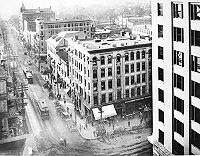 Intersection of Fayetteville and Martin Streets, c 1908
Intersection of Fayetteville and Martin Streets, c 1908
In 1912, Bloomsbury Park opened, featuring a popular carousel ride. Relocated to Pullen Park, the carousel is still operating.
From 1914-1917, an influenza epidemic killed 288 Raleigh citizens. The state of North Carolina lost a total of 5,799 men in World War I.
In 1922, WLAC signed on as the city's first radio station, but lasted only two years. WFBQ signed on in 1924 and became WPTF in 1927. It is now Raleigh's oldest continuous radio broadcaster.
On December 12, 1924, The Roman Catholic Diocese of Raleigh was officially established by the Vatican and the Sacred Heart Cathedral became the official seat of the diocese.
The city's first airport, Curtiss-Wright Flying Field opened in 1929. That same year, the stock market crash resulted in six Raleigh banks closing.[13]
During the difficult 1930s of the Great Depression, government at all levels was integral to creating jobs. The city provided recreational and educational programs, and hired people for public works projects. In 1932, Raleigh Memorial Auditorium was dedicated. The North Carolina Symphony, founded the same year, performed in its new home. From 1934-1937, the federal Civilian Conservation Corps constructed the area now known as William B. Umstead State Park. In 1939, the State General Assembly chartered the Raleigh-Durham Aeronautical Authority to build a larger airport between Raleigh and Durham, with the first flight occurring in 1943.
In 1947, Raleigh citizens adopted a council-manager form of government, the current form.
The Dorton Arena, a 7,610-seat multi-purpose arena designed by Matthew Nowicki, was opened in 1952 on the grounds of the North Carolina State Fair. It was listed in the National Register of Historic Places in 1973.
Raleigh experienced significant damage from Hurricane Hazel in 1954.
In 1956, WRAL-TV became the first local television station.
With the opening of the Research Triangle Park in 1959, Raleigh began to experience a population increase, resulting in a total city population of 100,000 by 1960.[14]
Following passage of the federal Voting Rights Act, one of the main achievements of the African-American Civil Rights Movement (1955-1968) and the Lyndon B. Johnson presidency, political participation and voting by African Americans in Raleigh increased rapidly. In 1967, Clarence E. Lightner was elected to the City Council, and in 1973 became Raleigh's first African-American mayor.
In 1976, the Raleigh City and Wake County schools merged to become the Wake County Public School System, now the largest school system in the state and 19th largest in the country.
During the 1970s and 1980s, the I-440 beltline was constructed, easing traffic congestion and providing access to most major city roads.
The first Raleigh Convention Center (replaced in 2008) and Fayetteville Street Mall were both opened in 1977. Fayetteville Street was turned into a pedestrian-only street in an effort to help the then-ailing downtown area, but the plan was flawed and business declined for years to come. Fayetteville Street was reopened in 2007 as the main thoroughfare of Raleigh's downtown.[15]
The 1988 Raleigh tornado outbreak of November 28, 1988, was the most destructive of the seven tornadoes reported in Northeastern North Carolina and southeastern Virginia between 1:00 AM and 5:45 AM. The Raleigh tornado produced over $77 million in F4 damage, along with four fatalities (two in the city of Raleigh, and two in Nash County) and 154 injuries. The damage path from the storm was measured at 84 miles (135 km) long, and .5 miles (0.8 km) wide at times.[16]
In 1991, two large skyscrapers in Raleigh were completed, First Union Capitol Center and Two Hannover Square, along with the popular Walnut Creek Amphitheatre in Southeast Raleigh.
In 1996, the Olympic Flame passed through Raleigh while on its way to the 1996 Summer Olympics in Atlanta, Georgia. Also in 1996, Hurricane Fran struck the area, causing massive flooding and extensive structural damage.
In 1997, the National Hockey League's Hartford Whalers announced their intention to move to Raleigh as the Carolina Hurricanes, becoming the City's first major league professional sports franchise.
In 1999, the Raleigh Entertainment and Sports Arena, later renamed the RBC Center, opened to provide a home for the Hurricanes and the NC State Wolfpack men's basketball team, as well as an up-to-date major concert venue.[17]
21st century
In the first decade of the 21st century, Raleigh was featured prominently in a number of "Top 10 Lists," including those by Forbes, MSNBC and Money Magazine, due to its quality of life and business climate.
In 2001, the Raleigh Memorial Auditorium complex was expanded with the addition of the Progress Energy Center for the Performing Arts, Meymandi Concert Hall, Fletcher Opera Theater, Kennedy Theatre, Betty Ray McCain Gallery and Lichtin Plaza.[18]
Fayetteville Street reopened to vehicular traffic in 2006. A variety of downtown building projects began around this time including the 34-story RBC Bank Tower, multiple condominium projects and several new restaurants. Additional skyscrapers are in the proposal/planning phase.
In 2006, the city's NHL franchise, the Carolina Hurricanes won the Stanley Cup, North Carolina's first and only professional sports championship.
With the opening of parts of I-540 from 2005–2007, a new 70-mile (110 km) loop around Wake County, traffic congestion eased somewhat in the North Raleigh area. Completion of the entire loop is expected to take another 15 years.
Plans are currently underway to build a combination of high-speed rail, light rail, and commuter rail lines to and from the city's core.
In 2008, the city's Fayetteville Street Historic District joined the National Register of Historic Places.
In September 2010, Raleigh hosted the inaugural Hopscotch Music Festival.
In January 2011, Raleigh hosted the National Hockey League All-Star Game.
In April 2011, a devasting EF-3 tornado hit Raleigh, and many other tornadoes touched down in the state (ultimately the largest, but not the strongest (1984 Carolinas tornado outbreak) outbreak to ever hit the state), killing 24 people. The tornado tracked northeast through parts of Downtown, East Central Raleigh and Northeast Raleigh and produced $115 million dollars in damages in Wake County. There were 4 fatalities in the city.
Geography
According to the United States Census Bureau, Raleigh occupies a total area of 115.6 square miles (299 km2), of which 114.6 square miles (297 km2) is dry land and 1.0 square mile (2.6 km2) (0.84%) is covered by water.
Raleigh is located in the northeast central region of North Carolina, where the North American Piedmont and Atlantic Coastal Plain regions meet. This area is known as the "fall line" because it marks the elevation inland at which waterfalls begin to appear in creeks and rivers. As a result, most of Raleigh features gently rolling hills that slope eastward toward the state's flat coastal plain. Its central Piedmont location situates Raleigh about two hours west of Atlantic Beach, North Carolina, by car and four hours east of the Great Smoky Mountains of the Appalachian range. The city is 145 miles (233 km) south of Richmond, Virginia; 232 miles (373 km) south of Washington, D.C.; and 143 miles (230 km) northeast of Charlotte, North Carolina.
Climate
Raleigh experiences a humid subtropical climate, with generally moderate temperatures during spring and autumn. Summers are typically hot. Winters are mild and wet with highs generally in the range of 47–53 °F (8–12 °C) with lows around or just below freezing, although an occasional 60 °F (16 °C) or warmer winter day is not uncommon. Lows may also fall into the 15-20 °F (-9 to -7 °C) range, but rarely any further. The record low temperature is −6 °F (−21 °C), set in January 1985. Spring and autumn features warm days and cool nights. Summer daytime highs average in the upper 80s to low 90s °F (31-34 °C) with warm and humid nights in the upper 60s (19-21 °C). Temperatures can reach 100 °F (38 °C). The region's rainiest months are January and March with the driest months being April and November.[19]
Raleigh receives an average of 6.0 inches (15.2 cm) of snow in winter. Freezing rain and sleet also occur most winters, and occasionally the area experiences a major damaging ice storm. On January 24–25, 2000, Raleigh received its greatest snowfall from a single storm - 20.3 inches (52 cm) - during the Winter Storm of January 2000. Storms of this magnitude are generally the result of cold air damming that affects the city due to its proximity to the Appalachian Mountains.
The region also experiences occasional periods of drought, during which the city sometimes has restricted water use by residents. During the late summer and early fall, Raleigh can experience hurricanes. In 1996, Hurricane Fran caused severe damage in the Raleigh area, mostly from falling trees. The most recent hurricane to have a considerable effect on the area was Isabel in 2003.
Climate data for Raleigh Month Jan Feb Mar Apr May Jun Jul Aug Sep Oct Nov Dec Year Record high °F (°C) 79
(26)82
(28)94
(34)95
(35)99
(37)103
(39)104
(40)103
(39)101
(38)96
(36)85
(29)85
(29)104
(40)Average high °F (°C) 51.4
(10.8)55.7
(13.2)63.8
(17.7)72.7
(22.6)79.4
(26.3)85.8
(29.9)88.9
(31.6)87.2
(30.7)81.8
(27.7)72.2
(22.3)63.0
(17.2)54.2
(12.3)71.34
(21.86)Average low °F (°C) 32.0
(0.0)34.0
(1.1)40.8
(4.9)48.1
(8.9)56.9
(13.8)65.0
(18.3)69.3
(20.7)68.2
(20.1)62.3
(16.8)50.2
(10.1)41.9
(5.5)34.9
(1.6)50.30
(10.17)Record low °F (°C) −6
(−21)−2
(−19)13
(−11)23
(−5)33
(1)41
(5)48
(9)48
(9)37
(3)24
(−4)15
(−9)0
(−18)−6
(−21)Precipitation inches (mm) 4.43
(112.5)3.60
(91.4)4.44
(112.8)2.98
(75.7)3.95
(100.3)4.05
(102.9)4.48
(113.8)4.23
(107.4)4.41
(112)3.58
(90.9)3.19
(81)3.21
(81.5)46.55
(1,182.4)Snowfall inches (cm) 2.0
(5.1)2.5
(6.4)1.1
(2.8)trace 0
(0)0
(0)0
(0)0
(0)0
(0)0
(0)0
(0).4
(1)6.0
(15.2)Avg. precipitation days (≥ 0.01 in) 10.4 9.2 10.1 8.1 9.4 8.9 10.2 8.9 8.0 6.6 8.0 9.4 107.2 Avg. snowy days (≥ 0.1 in) .6 .7 .4 0 0 0 0 0 0 0 0 .2 1.9 Sunshine hours 164.3 175.2 229.4 252.0 257.3 267.0 260.4 238.7 219.0 213.9 174.0 158.1 2,609.3 Source: NOAA [20] HKO (sun) [21] The Weather Channel (extreme temps) [22] Cityscape
Main article: Raleigh, North Carolina neighborhoodsRaleigh is divided into several major geographic areas, each of which use a Raleigh address and a ZIP code that begins with the digits 276. RBC Plaza, also known as RBC Tower, is the largest and tallest skyscraper in the city of Raleigh. The tower rises to a height of 538 feet (164 m), with a floor count of 34.
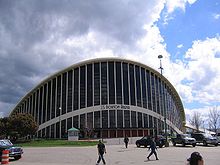 Dorton Arena in Raleigh designed by Matthew Nowicki
Dorton Arena in Raleigh designed by Matthew Nowicki
Downtown/Old Raleigh ("Inside the Beltline" or ITB) is home to historic neighborhoods and buildings such as the Sir Walter Raleigh Hotel built in the early 20th century, the restored City Market, the Fayetteville Street downtown business district, the Cameron Village midtown business district, as well as the North Carolina Museum of History, North Carolina Museum of Natural Sciences, North Carolina State Capitol, Peace College, the Raleigh City Museum, Raleigh Convention Center, RBC Plaza, Shaw University, and St. Augustine's College. The neighborhoods in Old Raleigh include Cameron Park, Boylan Heights,[23] Country Club Hills, Coley Forest, Five Points, Budleigh, Glenwood-Brooklyn, Hayes Barton Historic District, Moore Square, Mordecai, Rosengarten Park, Belvidere Park, Woodcrest, and Historic Oakwood.
Outer Beltline
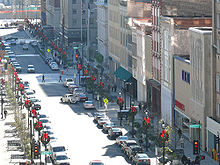 Fayetteville Street in downtown Raleigh in December
Fayetteville Street in downtown Raleigh in December
Midtown Raleigh, is a residential and commercial area just North of the I-440 Beltline and is part of North Raleigh. It is roughly framed by Glenwood/Creedmoor Road to the West, Wake Forest Road to the East, and Millbrook Road to the North. It includes shopping centers such as North Hills and Crabtree Valley Mall. It also includes North Hills Park and part of the Raleigh Greenway System. The term was coined by the Greater Raleigh Chamber of Commerce, developer John Kane and planning director Mitchell Silver. The News & Observer newspaper started using the term for marketing purposes only.[24]
Uptown Raleigh, is a residential and commercial area at the intersection of Glenwood and Creedmoor adjacent to the Beltline. Crabtree Valley Mall is the anchor of the area. This label is not used by anyone. The Soleil Center, what was to be the second tallest building in Raleigh at 480, was planned to be built here, but due to the financial Crisis of 2008 lost funding and now is stalled. This enclave is still considered to be part of North Raleigh, because in the past it was known as the outskirts of Raleigh, a very rural country land. The 27612 zip code is the most popular zip code in this area. The main roads are Millbrook Road and North Hills Drive.
East Raleigh is situated roughly from Capital Boulevard near the I-440 beltline to New Hope Road. Most of East Raleigh's development is along primary corridors such as U.S. 1 (Capital Boulevard), New Bern Avenue, Poole Road, Buffaloe Road, and New Hope Road. Neighborhoods in East Raleigh include New Hope, and Wilder's Grove. The area is bordered to the east by the town of Knightdale.
West Raleigh lies along Hillsborough Street and Western Boulevard. The area is bordered to the west by suburban Cary. It is home to North Carolina State University, Meredith College, Pullen Park, Pullen Memorial Baptist Church, Cameron Village, Lake Johnson, the North Carolina Museum of Art and historic Saint Mary's School. Primary thoroughfares serving West Raleigh, in addition to Hillsborough Street, are Avent Ferry Road, Blue Ridge Road, and Western Boulevard. West Raleigh is also home to the nation's smallest Roman Catholic cathedral, Sacred Heart Cathedral. The RBC Center is also located here adjacent to the North Carolina State Fairgrounds.
North Raleigh is an expansive, diverse, and fast-growing suburban area of the city that is home to established neighborhoods to the south along with many newly built subdivisions and along its northern fringes. The area generally falls North of Millbrook Road. It is primarily suburban with large shopping areas. Primary neighborhoods and subdivisions in North Raleigh include Bedford, Bent Tree, Brentwood, Brier Creek, Brookhaven, Black Horse Run, Crossgate, Crosswinds, Falls River, Hidden Valley, Lake Park, North Haven, North Ridge, Oakcroft, Shannon Woods, Six Forks Station, Springdale, Stonebridge, Stone Creek, Stonehenge, Valley Estates, Wakefield, Windsor Forest, and Wood Valley. The area is served by a number of primary transportation corridors including Glenwood Avenue (U.S. Route 70), Interstate 540, Wake Forest Road, Millbrook Road, Lynn Road, Six Forks Road, Spring Forest Road, Creedmoor Road, Leesville Road, Strickland Road, and North Hills Drive.
Northeast Raleigh is a subsection of North Raleigh. Northeast Raleigh is the most diverse section of the city with a near even mix of White Americans, Black Americans, Hispanics, and Asian-Americans. Northeast Raleigh is anchored by Capital Boulevard and the Mini City area. The Triangle Town Center mall is the closest mall, and the area is served by CAT bus routes #1, #23c, #24c, #25c, and #26c.
South Raleigh is located along U.S. 401 South toward Fuquay-Varina and along US 70 into suburban Garner. This area is the least developed and least dense area of Raleigh (much of the area lies within the Swift Creek watershed district, where development regulations limit housing densities and construction). The area is bordered to the west by Cary, to the east by Garner, and to the southwest by Holly Springs. Neighborhoods in South Raleigh include Lake Wheeler, Swift Creek, Riverbrooke, and Enchanted Oaks.
Southeast Raleigh is bounded by downtown on the west, Garner on the southwest, and rural Wake County to the southeast. The area includes areas along Rock Quarry Road, Martin Luther King Jr. Boulevard, and New Bern Avenue. This area is very diverse, with new suburban developments to poor inner-city neighborhoods. Many of the older neighborhoods are historically African American and date back to the end of the Civil War. Primary neighborhoods include Chavis Heights, Raleigh Country Club, Southgate, Kingwood Forest and Biltmore Hills. Time Warner Cable Music Pavilion (formerly Alltel Pavilion and Walnut Creek Amphitheatre) is one of the region's major outdoor concert venues and is located on Rock Quarry Road. Shaw University, the oldest HBCU in the South, is located between Martin Luther King Jr. Boulevard and South Street in this part of the city.
Demographics
Historical populations Census Pop. %± 1800 669 — 1810 976 45.9% 1820 2,674 174.0% 1830 1,700 −36.4% 1840 2,244 32.0% 1850 4,518 101.3% 1860 4,780 5.8% 1870 7,790 63.0% 1880 9,265 18.9% 1890 12,678 36.8% 1900 13,643 7.6% 1910 19,218 40.9% 1920 24,418 27.1% 1930 37,379 53.1% 1940 46,879 25.4% 1950 65,679 40.1% 1960 93,931 43.0% 1970 122,830 30.8% 1980 150,255 22.3% 1990 212,092 41.2% 2000 276,093 30.2% 2010 403,892 46.3% According to the 2010 Census, the racial composition of the city was:[25]
- 57.5% White (53.3% non-Hispanic white)
- 29.3% Black or African American
- 11.3% Hispanic or Latino American (5.9% Mexican, 1.1% Puerto Rican, 0.9% Salvadoran, 0.6% Honduran, 0.3% Cuban, 0.3% Colombian, 0.2% Guatemalan, 0.2% Peruvian)
- 4.3% Asian American (1.2% Indian, 0.8% Chinese, 0.7% Vietnamese, 0.5% Korean, 0.4% Filipino, 0.1% Pakistani, 0.1% Japanese)
- 0.5% Native American
- less than 0.1% Native Hawaiian or Other Pacific Islander,
- 1.4% some other race
- 2.6% two or more races.
As of the 2000 United States census,[3] there were 276,093 persons (July 2008 estimate was 380,173) and 61,371 families residing in Raleigh. The population density was 2,409.2 people per square mile (930.2/km²). There were 120,699 housing units at an average density of 1,053.2 per square mile (406.7/km²). The racial composition of the city was: 63.31% White, 27.80% Black or African American, 7.01% Hispanic or Latino American, 3.38% Asian American, 0.36% Native American, 0.04% Native Hawaiian or Other Pacific Islander, 3.24% some other race, and 1.88% two or more races.
There were 112,608 households in the city in 2000, of which 26.5% included children below the age of 18, 39.5% were composed of married couples living together, 11.4% reported a female householder with no husband present, and 45.5% classified themselves as nonfamily. In addition, 33.1% of all households were composed of individuals living alone, of which 6.2% was someone 65 years of age or older. The average household size in Raleigh was 2.30 persons, and the average family size was 2.97 persons.
Raleigh's population in 2000 was evenly distributed with 20.9% below the age of 18, 15.9% aged 18 to 24, 36.6% from 25 to 44, and 18.4% from 45 to 64. An estimated 8.3% of the population was 65 years of age or older, and the median age was 31 years. For every 100 females, there were 98.0 males; for every 100 females aged 18 or older, there were 96.6 males aged 18 or older.
The median household income in the city was $46,612 in 2000, and the median family income was $60,003. Males earned a median income of $39,248, versus $30,656 for females. The median per capita income for the city was $25,113, and an estimated 11.5% of the population and 7.1% of families were living below the poverty line. Of the total population, 18.8% of those below the age of 18, and 9.3% of those 65 and older, were living below the poverty line.
Law and government
Raleigh operates under a council-manager government. Raleigh City Council consists of eight members; all seats, including the Mayor's, are open for election every two years. Five of the council seats are district representatives and two seats are citywide representatives elected at-large. Historically, Raleigh voters have tended to elect conservative Democrats in local, state, and national elections, a holdover from their one-party system of the late 19th century.
City Council
Main article: Raleigh City Council- Charles Meeker, Mayor
- Nancy McFarlane, Council Member (District A, north-central Raleigh)
- John Odom, Council Member (District B, northeast Raleigh)
- Eugene Weeks, Council Member (District C, southeast Raleigh)
- Thomas Crowder, Council Member (District D, southwest Raleigh)
- Bonner Gaylord, Council Member (District E, west and northwest Raleigh)
- Russ Stephenson, Council Member, At-Large
- Mary-Ann Baldwin, Council Member, At-large
Crime
In 2008, 34 murders or non-negligent cases of manslaughter were reported within Raleigh's city limits, per the Federal Bureau of Investigation's Uniform Crime Reports.
Mayor Charles Meeker is a member of the Mayors Against Illegal Guns Coalition,[26] a bi-partisan group with a stated goal of "making the public safer by getting illegal guns off the streets." The coalition is co-chaired by Boston Mayor Thomas Menino and New York City Mayor Michael Bloomberg.
Raleigh averages a rate of 469.2 motor vehicle thefts per year per 100,000 residents, below the average rate of 528.4 motor vehicle thefts per year per 100,000 residents for all metropolitan areas in North Carolina.
According to the Uniform Crime Reports, crime in Raleigh has steadily decreased in recent years. In 2004, there were 580 reported incidents of violent crime and 3,768 reported incidents of property crime reported per 100,000 population. Nationally there were 466 violent crimes and 3,517 property crimes reported per 100,000 population, while U.S. cities with a population between 250,000 and 500,000 residents reported 978 violent crimes and 5,631 property crimes per 100,000 population,.[27]
Economy
Raleigh's industrial base includes banking/financial services; electrical, medical, electronic and telecommunications equipment; clothing and apparel; food processing; paper products; and pharmaceuticals. Raleigh is part of North Carolina's Research Triangle, one of the country's largest and most successful research parks and a major center in the United States for high-tech and biotech research, as well as advanced textile development.[28] The city is a major retail shipping point for eastern North Carolina and a wholesale distributing point for the grocery industry.
Several films have been shot in Raleigh and its surrounding areas.
In 2009 the Raleigh-Cary Metropolitan Statistical Area (MSA) placed #5 on WomenCo.'s list of the Top 25 Cities for Your Career.[29]
Education
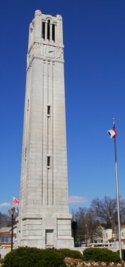 Memorial Bell Tower at North Carolina State University
Memorial Bell Tower at North Carolina State University
 Raleigh Charter High School main entrance
Raleigh Charter High School main entrance
As of 2011, Time ranked Raleigh, NC as the third most educated city in the US based on the percentage of residents who held college degrees.[30] This statistic can most likely be credited to the presence of universities in and around Raleigh, as well as the presence of Research Triangle Park to the Northwest.
Higher education
Public
Private
- Meredith College
- William Peace University
- Shaw University
- St. Augustine's College
- Campbell University Norman Adrian Wiggins School of Law
- Skema Business School, the first French Business School to open a campus in the USA
Private, for profit
- ECPI College of Technology
- Strayer University
- Mitchell's Hair Styling Academy
- The Emerald Academy - A Paul Mitchell Partner School
Primary and secondary education
Public schools
Main article: Wake County Public School SystemPublic schools in Raleigh are operated by the Wake County Public School System. Observers have praised the Wake County Public School System for its innovative efforts to maintain a socially, economically and racial balanced system by using income as a prime factor in assigning students to schools.[31] Raleigh is home to four magnet high schools; Needham B. Broughton High School, William G. Enloe High School, Southeast Raleigh High School, Millbrook High School.
Charter schools
The State of North Carolina provides for a legislated number of charter schools. These schools are administered independently of the Wake County Public School System. Raleigh is currently home to eleven such charter schools:
- Casa Esperanza Montessori School (K-8)
- Endeavor Charter School (K-8)
- Exploris Middle School (6-8)
- Hope Elementary School (K-5)
- John H. Baker, Jr., High School (9-12)
- Magellan Charter School (3-8)
- PreEminent Charter School (K-8)
- Quest Academy (K-8)
- Raleigh Charter High School (9-12)
- Torchlight Academy (K-6)
- Wake Early College of Health and Sciences (9-12)
- Woods Charter School (K-12)
Private and religion-based schools
- Al-Iman Islamic School (K-8)
- Bonner Academy (5-8)
- Follow the Child Montessori School (K-6)
- Friendship Christian School of Raleigh (Baptist, 1-12)
- Gethsemane Seventh-day Adventist Church School (K-8)
- Jewish Academy of Wake County (K-3)
- Montessori School of Raleigh (K-9)
- Neuse Baptist Christian School (K-12)
- North Raleigh Christian Academy (Baptist, K-12)
- Raleigh Christian Academy (Baptist, K-12)
- The Raleigh School (K-5)
- Ravenscroft School (K-12)
- St. David's School (Episcopal, K-12)
- St. Mary's School (Episcopal, 9-12)
- St. Timothy's School (Episcopal, K-8)
- The Trilogy School (2-12)
- Trinity Academy of Raleigh (Classical, Christian, K-12)
- Upper Room Christian Academy (PreK-12)
- Wake Christian Academy (K-12)
- Word of God Christian Academy
- Catholic secondary schools
- Cardinal Gibbons High School (Catholic, 9-12)
- St. Thomas More Academy (Catholic, 9-12)
- Catholic primary schools
- The Franciscan School (Catholic, K-8)
- Cathedral School (Catholic, PreK-8)
- Our Lady of Lourdes Catholic School (K-8)
- St. Raphael the Archangel Catholic School (PreK-8)
Cultural resources
Museums
- African American Cultural Complex
- Contemporary Art Museum
- Gregg Museum of Art & Design at NCSU
- Haywood Hall House & Gardens
- North Carolina Museum of Art
- North Carolina Museum of Natural Sciences
- North Carolina Museum of History
- North Carolina Sports Hall of Fame
- Raleigh City Museum
- Marbles Kids Museum
- J. C. Raulston Arboretum
- Joel Lane House
- Mordecai House
- Montfort Hall
- Pope House Museum
Performing arts
The Time Warner Cable Music Pavilion at Walnut Creek hosts major international touring acts. The Progress Energy Center for the Performing Arts complex houses the Raleigh Memorial Auditorium, the Fletcher Opera Theater, the Kennedy Theatre, and the Meymandi Concert Hall. During the North Carolina State Fair, Dorton Arena hosts headline acts. In 2008, a new theatre space, the Meymandi Theatre at the Murphey School, was opened in the restored auditorium of the historic Murphey School [1]. Theater performances are also offered at the Raleigh Little Theatre, Long View Center, Theatre in the Park, and Stewart and Thompson Theaters at North Carolina State University.
Raleigh is home to several professional arts organizations, including the North Carolina Symphony, the Opera Company of North Carolina, Burning Coal Theatre Company, the North Carolina Theatre, Broadway Series South and the Carolina Ballet. The numerous local colleges and universities significantly add to the options available for viewing live performances.
Visual arts
North Carolina Museum of Art, occupying a large suburban campus on Blue Ridge Road near the North Carolina State Fairgrounds, maintains one of the premier public art collections located between Washington, D.C., and Atlanta. In addition to its extensive collections of American Art, European Art and ancient art, the museum recently has hosted major exhibitions featuring Auguste Rodin (in 2000) and Claude Monet (in 2006-07), each attracting more than 200,000 visitors.[32][33] Unlike most prominent public museums, the North Carolina Museum of Art acquired a large number of the works in its permanent collection through purchases with public funds. The museum's outdoor park is one of the largest such art parks in the country. The museum facility underwent a major expansion which greatly expanded the exhibit space that was completed in 2010. The 127,000 sf new expansion is designed by NYC architect Thomas Phifer and Partners.
Raleigh's downtown is also home to many local art galleries such as Art Space and Visual Art Exchange in City Market and Bee Hive Studios on Harget Street. CAM Raleigh is a downtown modern art museum that serves to promote new artists and does not house a permanent collection. CAM Raleigh was designed by the award-winning architectural firm Brooks+Scarpa of Los Angeles, CA.
Sports and leisure
Professional
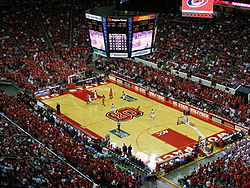 The RBC Center in Raleigh
The RBC Center in Raleigh
The National Hockey League's Carolina Hurricanes franchise moved to Raleigh in 1997 from Hartford, Connecticut (where it was known as the Hartford Whalers). The team played its first two seasons more than 60 miles away in Greensboro while its home arena, Raleigh's RBC Center, was under construction. The Hurricanes are the only major league (NFL, NHL, NBA, MLB) professional sports team in North Carolina to have won a championship, winning the Stanley Cup in 2006, over the Edmonton Oilers. The city played host to the 2011 NHL All-Star Game.
In addition to the Hurricanes, the Carolina RailHawks FC of the North American Soccer League play in suburban Cary to the west; the Carolina Mudcats, an AA minor-league baseball team, play in the city's eastern suburbs; and the Durham Bulls, the AAA minor-league baseball team made internationally famous by the movie Bull Durham, play in the neighboring city of Durham.
Several other professional sports leagues have had former franchises (now defunct) in Raleigh, including the Arena Football League; the World League of American Football; the Raleigh Cougars of the United States Basketball League; and most recently, the Carolina Courage of the Women's United Soccer Association (in suburban Cary), which won that league's championship Founders Cup in 2002.
The Research Triangle region has hosted the Professional Golfers' Association (PGA) Nationwide Tour Rex Hospital Open since 1994, with the current location of play at Raleigh's Wakefield Plantation.
Collegiate
North Carolina State University is located in southwest Raleigh where the Wolfpack competes nationally in 24 intercollegiate varsity sports as an original member of the Atlantic Coast Conference. The university's football team plays in Carter-Finley Stadium, the third largest football stadium in North Carolina, while the men's basketball team shares the RBC Center with the Carolina Hurricanes hockey club.[citation needed]
Amateur
The North Carolina Tigers compete as an Australian Rules football club in the United States Australian Football League, in the Eastern Australian Football League.
Raleigh is also home to the Carolina Rollergirls, an all-women flat-track roller derby team that is a competing member of the Women's Flat Track Derby Association. The Carolina Rollergirls compete at Dorton Arena at the North Carolina State Fairgrounds.
Raleigh is also home to one of the Cheer Extreme All Stars gyms. In 2009 and again in 2010, Cheer Extreme Raleigh's Small Senior Level 5 Team placed 2nd at the Cheerleading Worlds Competition in Orlando, Florida.
Recreation
The Raleigh Parks and Recreation Department offers a wide variety of leisure opportunities at more than 150 sites throughout the city, which include: 8,100 acres (33 km2) of park land, 54 miles (87 km) of greenway, 22 staffed community centers, a BMX championship-caliber race track, 112 tennis courts among 25 locations, 5 public lakes, and 8 public aquatic facilities.
The J. C. Raulston Arboretum, an 8 acre (32,000 m²) arboretum and botanical garden in west Raleigh administered by North Carolina State University, maintains a year-round collection that is open daily to the public without charge.
Transportation
Air
Raleigh-Durham International Airport
Main article: Raleigh-Durham International Airport(IATA: RDU, ICAO: KRDU, FAA LID: RDU)
Raleigh-Durham International Airport, the region's primary airport and the second-largest in North Carolina, located northwest of downtown Raleigh via Interstate-40 between Raleigh and Durham, serves the city and greater Research Triangle metropolitan region, as well as much of eastern North Carolina. The airport offers service to more than 35 domestic and international destinations and serves approximately 10 million passengers a year.[34] The airport also offers facilities for cargo and general aviation. The airport authority tripled the size of its Terminal 2 (formerly Terminal C) in January 2011.
Private airports
Several licensed private general-aviation airports operate in Raleigh's immediate suburban areas:
- Bagwell Airport (FAA LID: NC99), Garner
- Ball Airport (FAA LID: 79NC), Louisburg
- Cox Airport (FAA LID: NC81), Apex
- Deck Airpark Airport (FAA LID: NC11), Apex
- Field of Dreams Airport (FAA LID: 51NC), Zebulon
- Fuquay/Angier Field Airport (FAA LID: 78NC), Fuquay-Varina
- North Raleigh Airport (FAA LID: 00NC), Louisburg
- Peacock Stolport Airport (FAA LID: 4NC7), Garner
- Raleigh East Airport (FAA LID: 9NC0), Knightdale
- Triple W Airport (ICAO: K5W5, FAA LID: 5W5), Raleigh
Freeways and primary designated routes
- Interstate Highways
- I-40 traverses the southern part of the city, connecting Raleigh to Durham and Chapel Hill toward the west, and coastal Wilmington, North Carolina to the southeast.
- I-440, Also known locally as the Raleigh Beltline, it makes a loop around the central part of the city. The I-440 route labeling formerly encompassed the entire loop around the city, co-numbered though South Raleigh with I-40. In 2002, the NCDOT removed the I-440 designation from the co-numbered I-40 (southern and southwestern) sections of the loop, and the directional signage on the remaining I-440 portion was changed from Inner/Outer to East/West. The route designation changes were made to avoid driver confusion over the Inner/Outer designations, especially with Raleigh's new "Outer Beltline," as I-540 has become known.
- I-540/NC 540 is currently under development. It is a partially completed outer beltway that will run around the outer edges of Wake County and into a small portion of southeast Durham county. The route is complete and currently open between the NC 55 interchange in suburban Cary and the US-64/US-264 interchange in suburban Knightdale.
- United States Highways
- U.S. Route 1 enters the city from the north along Capital Boulevard, joins I-440 around the west side of Raleigh, and leaves the city to the southwest as the US 1/US 64 expressway in Cary.
- U.S. Route 64 is the main east-west route through Raleigh; all segments share routes with another highway. East of the city, US-64/US-264 is known as the Knightdale Bypass. US 64 follows I-440 (as a wrong way concurrency) and I-40 along southern Raleigh, and US 1 to the southwest.
- U.S. Route 70 runs roughly northwest-southeast through Raleigh. North of downtown, the route follows Glenwood Avenue into Durham. South of Raleigh, the route (along with US 401 and NC 50) follows South Saunders and South Wilmington Streets into Garner. Through downtown, US 70 uses small segments of several streets, including Wade Avenue, Capital Boulevard, Dawson, and McDowell Streets.
- U.S. Route 264 cosigned with US 64 through East Raleigh.
- U.S. Route 401 north of downtown Raleigh it follows Capital Boulevard and Louisburg Road. South of downtown it is cosigned with US 70 from Wade Avenue southward.
- N.C. Route 54 follows Chapel Hill Road and Hillsborough Street in West Raleigh. The route ends at its interchange with I-440.
- N.C. Route 50 is a north-south route through Raleigh. North of Raleigh it follows Creedmoor Road. NC 50 joins US 70 and later US 401 in downtown Raleigh. The three routes remain together through south Raleigh.
- N.C. Route 98, known as Durham Road in North Raleigh, traverses the extreme northern parts of the city.
Intercity rail
Raleigh's train station is one of Amtrak's busiest stops in the Southern U.S.[35] The station is served by four passenger trains daily: the Silver Star, twice-daily Piedmont service, and the Carolinian.[36] Daily service is offered between Raleigh and:
- Charlotte, with intermediate stops including Cary, Durham, Burlington and Greensboro, North Carolina.
- New York City, with intermediate stops including Richmond, Virginia; Washington, D.C.; Baltimore; and Philadelphia.
- Miami, with intermediate stops including Columbia, South Carolina, and Savannah, Georgia; as well as Jacksonville, Orlando and Tampa, Florida.
- Greyhound lines are provided as inter-city bus lines
Public transit
Public transportation in and around Raleigh is provided by Capital Area Transit (CAT),[37] which operates 43 fixed bus routes, including the R-Line[38] and the Wake-Forest Loop. Although there are 43 routes, some routes are designed to cover multiple other routes at times when they are not served. Depending on the time of the day, and the day of the week, the number of routes operating is between 5 and 29.
Raleigh is also served by Triangle Transit (known formerly as the Triangle Transit Authority, or TTA). Triangle Transit offers scheduled, fixed-route regional and commuter bus service between Raleigh and the region's other principal cities of Durham, Cary and Chapel Hill, as well as to and from the Raleigh-Durham International Airport, Research Triangle Park and several of the region's larger suburban communities. Triangle Transit also coordinates an extensive vanpool and rideshare program that serves the region's larger employers and commute destinations.
North Carolina State University also maintains its own transit system, the Wolfline, that provides zero-fare bus service to the general public along multiple routes serving the university's campuses in southwest Raleigh.
Government agencies throughout the Raleigh-Durham metropolitan area have struggled with determining the best means of providing fixed-rail transit service for the region.
From 1995 the cornerstone of Triangle Transit's long-term plan was a 28-mile rail corridor from northeast Raleigh, through downtown Raleigh, Cary, and Research Triangle Park, to Durham using DMU technology. There were proposals to extend this corridor 7 miles to Chapel Hill with light rail technology. However, in 2006 Triangle Transit deferred implementation indefinitely when the Federal Transit Administration declined to fund the program due to low ridership projections.
The region's two metropolitan planning organizations appointed a group of local citizens in 2007 to reexamine options for future transit development in light of Triangle Transit's problems. The Special Transit Advisory Commission (STAC) retained many of the provisions of Triangle Transit's original plan, but recommended adding new bus services and raising additional revenues by adding a new local half-cent sales tax to fund the project.[39]
Bicycle and pedestrian
- The Maine-to-Florida U.S. Bicycle Route#1 routes through suburban Raleigh, along with N.C. Bicycle Route #2, the "Mountains To Sea" route. As of September 2010, maps and signage for both US Bike Route #1 and NC Bike Route #2 are out-of-date for the Raleigh area. N.C. Bicycle Route #5 is routed nearby, connecting Apex to Wilmington and closely paralleling the NCBC Randonneurs 600 kilometer brevet route.[40]
- Most public buses are equipped with bicycle racks, and some roads have dedicated bicycle-only lanes. Bicyclists and pedestrians also may use Raleigh's extensive greenway system, with paths and trails located throughout the city.
- In May 2011, Raleigh was designated a Bicycle Friendly Community by the League of American Bicyclists at the Bronze level.[41]
- A 2011 study by Walk Score ranked Raleigh 36th most walkable of fifty largest U.S. cities.[42]
Media
Print publications
There are several newspapers and periodicals serving Raleigh:
- The News & Observer, a large daily newspaper owned by The McClatchy Company
- The Raleigh Telegram, a print and online community newspaper
- Raleigh Magazine, an upscale slick glossy magazine published by The Raleigh Telegram
- Technician, student publication of North Carolina State University
- New Raleigh, a popular Raleigh news blog that covers entertainment and other news
- The Carolinian, North Carolina's oldest and largest African-American newspaper published twice weekly
- Metro Magazine, a Raleigh lifestyle magazine with food columns, book reviews, and more
- Midtown Magazine an upscale Raleigh lifestyle magazine
- The Raleigh Downtowner, a monthly print magazine about downtown Raleigh
- The Slammer, a paid bi-weekly newspaper featuring Raleigh crime news
- Carolina Journal, a free monthly newspaper
- Independent Weekly, a free weekly tabloid covering Raleigh, Durham, and the surrounding area
Television
Main article: The Triangle (North Carolina)#TelevisionBroadcast
Raleigh is part of the Raleigh-Durham-Fayetteville Designated Market Area, the 25th largest broadcast television market in the United States. The following stations are licensed to Raleigh and/or have significant operations and viewers in the city:
- WUNC-TV (4, PBS) licensed to Chapel Hill, owned by the University of North Carolina
- WRAL-TV (5, CBS): licensed to the city of Raleigh, owned by Capitol Broadcasting Company
- WTVD (11, ABC): licensed to the city of Durham. News bureau located in Raleigh, owned by ABC (The Walt Disney Company)
- WNCN-TV (17, NBC): studios located in Raleigh, licensed to the city of Goldsboro southeast of Raleigh; owned by Media General
- WLFL-TV (22, CW): licensed to the city of Raleigh, owned by Sinclair Broadcast Group
- WRDC (28, MyNetworkTV) licensed to Durham, owned by Sinclair Broadcast Group
- WRAY-TV (30, Independent/Jewelry TV) licensed to Wilson, owned by Multicultural Broadcasting
- WUVC-TV (40, Univision) licensed to Fayetteville, owned by Univision.
- WRAZ-TV (50, Fox): licensed to the city of Raleigh, owned by Capitol Broadcasting Company
- WAUG-TV (68, Independent station) licensed to Raleigh, owned and operated by Saint Augustine's College
Subscriber
Raleigh is home to the Research Triangle Region bureau of the regional cable news channel News 14 Carolina.
Broadcast radio
Public and listener-supported
- WKNC-FM (College rock), operated by students of North Carolina State University
- WSHA-FM (Jazz), operated by Shaw University
- WCPE-FM (Classical)
- WUNC-FM (National Public Radio, North Carolina Public Radio) operated by the University of North Carolina at Chapel Hill
Commercial
- WDCG-FM (G105, Contemporary Hit Radio)
- WQDR-FM (94.7QDR, Country)
- WBBB-FM 96.1 (96rock, Classic rock)
- WRAL-FM (Mix 101.5, Adult Contemporary)
- WKIX-FM (KIX 102.9, Classic Hits)
- WPTF-AM (NewsRadio 680, News/Talk)
- WQOK-FM (K97.5, Hip Hop)
- WFXC-FM (Foxy 107/104, Urban Adult Contemporary)
- WFXK-FM (Foxy 107/104, Urban Adult Contemporary)
- WRVA-FM (100.7 The River, Classic Hits)
- WKSL-FM (93.9 Kiss FM, (Rhythmic Adult Contemporary)
- WRDU-FM (106.1 Rush Radio, News/Talk
- WNNL-FM (103.9 The Light, Urban Gospel)
- WKIX-AM (Oldies)
- WQDR-AM (Classic Country)
- WCLY-AM (ESPN Deportes)
- WAUG-AM
Sister cities
Raleigh has several sister cities:[43][44]
 Xiangyang (formerly Xiangfan), Hubei, People's Republic of China[45]
Xiangyang (formerly Xiangfan), Hubei, People's Republic of China[45] Compiègne, France
Compiègne, France Kingston upon Hull, United Kingdom
Kingston upon Hull, United Kingdom Rostock, Germany
Rostock, Germany
Notable people
Source:[46]
- Chris Wilcox, Basketball player for Detroit Pistons.
- David Sedaris, writer
- Michael C. Hall, actor
- Evan Rachel Wood, actress
- Darrius Barnes, professional soccer player, currently plays for New England Revolution
- John Wall, NBA Player Drafted 1st overall in the 2010 NBA Draft; plays for the Washington Wizards
- Liz Vassey, actress All My Children
- Robert Duncan McNeill, director, actor All My Children, Star Trek: Voyager
- Emily Procter, actress Leaving Las Vegas and CSI: Miami
- Todd Duffey, actor
- Josh Hamilton, baseball player for the Texas Rangers
- Clay Aiken, singer and actor
- Landon Powell, Oakland Athletics catcher. Caught Dallas Braden's perfect game.
- Webb Simpson, professional golfer on the PGA Tour
Further information: List of people from Raleigh, North CarolinaSee also
- The Triangle (North Carolina)
- I-85 Corridor
- Capital Area Transit (CAT)
- Triangle Transit
- Raleigh-Durham International Airport
References
- ^ a b "Table 1: Annual Estimates of the Population for Incorporated Places Over 100,000, Ranked by July 1, 2008 Population: April 1, 2000 to July 1, 2008" (CSV). 2008 Population Estimates. United States Census Bureau, Population Division. July 1, 2008. http://www.census.gov/popest/cities/tables/SUB-EST2008-01.csv. Retrieved July 2, 2009.
- ^ "Annual Estimates of the Population of Metropolitan and Micropolitan Statistical Areas: April 1, 2000 to July 1, 2008" (CSV). 2008 Population Estimates. United States Census Bureau, Population Division. July 1, 2009. http://www.census.gov/popest/metro/files/2008/CSA-EST2008-alldata.csv. Retrieved July 2, 2009.
- ^ a b "American FactFinder". United States Census Bureau. http://factfinder.census.gov. Retrieved 2008-01-31.
- ^ "US Board on Geographic Names". United States Geological Survey. 2007-10-25. http://geonames.usgs.gov. Retrieved 2008-01-31.
- ^ Wells, John C. (2009). "Ralegh, Raleigh". Longman Pronunciation Dictionary. London: Pearson Longman. ISBN 9781405881180.
- ^ "Population & Census Information". City of Raleigh. http://www.raleighnc.gov/portal/server.pt/gateway/PTARGS_0_2_306_202_0_43/http%3B/pt03/DIG_Web_Content/category/Resident/Raleigh_At_A_Glance/Cat-1C-20051006-152447-Raleigh_Demographics.html. Retrieved 2009-08-21.
- ^ "Cary third fastest growing city in ’08; Raleigh is 8th, Durham 16th". wral.com. July 1, 2009. http://www.wral.com/business/story/5481659/. Retrieved July 2, 2009.
- ^ Raleigh Durham Annexation Agreement Lines
- ^ Bishir, Catherine (2005). North Carolina Architecture. UNC Press. pp. 73. ISBN 9780807856246. http://books.google.com/?id=NccTgQkmPIEC.
- ^ "City of Raleigh Years (1587 - 1844)". City of Raleigh. http://www.raleigh-nc.org/portal/server.pt/gateway/PTARGS_0_2_306_202_0_43/http%3B/pt03/DIG_Web_Content/category/Resident/Raleigh_At_A_Glance/History_of_Raleigh/Cat-2CA-2006109-095008-History_of_Raleigh__1587.html. Retrieved 2008-03-17.
- ^ "About John Haywood". NSCDA. http://haywoodhall.org/Haywood/haywood.html. Retrieved 2006-09-07.
- ^ "The Battle of Morrisville". Ernest Dollar. http://www.mindspring.com/~nixnox/history2.html. Retrieved 2008-03-17.
- ^ "City of Raleigh Years (1889 - 1930)". City of Raleigh. http://www.raleighnc.gov/portal/server.pt/gateway/PTARGS_0_2_306_202_0_43/http%3B/pt03/DIG_Web_Content/category/Resident/Raleigh_At_A_Glance/History_of_Raleigh/Cat-2CA-2006109-122719-Years__1889___1930.html. Retrieved 2008-03-17.
- ^ "City of Raleigh Years (1931 - 1965)". City of Raleigh. http://www.raleighnc.gov/portal/server.pt/gateway/PTARGS_0_2_306_202_0_43/http%3B/pt03/DIG_Web_Content/category/Resident/Raleigh_At_A_Glance/History_of_Raleigh/Cat-2CA-2006109-131835-Years__1931___1965.html. Retrieved 2008-03-17.
- ^ "City of Raleigh Years (1966 - 1990)". City of Raleigh. http://www.raleighnc.gov/portal/server.pt/gateway/PTARGS_0_2_306_202_0_43/http%3B/pt03/DIG_Web_Content/category/Resident/Raleigh_At_A_Glance/History_of_Raleigh/Cat-2CA-2006109-140652-Years__1966___1990.html. Retrieved 2008-03-17.
- ^ Gonski, Rod (2004-11-03). "Raleigh Tornado, November 28, 1988". National Weather Service. http://www4.ncsu.edu/~nwsfo/storage/cases/19881128/. Retrieved 2009-04-17.
- ^ "City of Raleigh Years (1991 - 1999)". City of Raleigh. http://www.raleighnc.gov/portal/server.pt/gateway/PTARGS_0_2_306_202_0_43/http%3B/pt03/DIG_Web_Content/category/Resident/Raleigh_At_A_Glance/History_of_Raleigh/Cat-2CA-2006109-150347-Years__1991___1999.html. Retrieved 2008-03-17.
- ^ "City of Raleigh Years (1999 - 2002)". City of Raleigh. http://www.raleighnc.gov/portal/server.pt/gateway/PTARGS_0_2_306_202_0_43/http%3B/pt03/DIG_Web_Content/category/Resident/Raleigh_At_A_Glance/History_of_Raleigh/Cat-2CA-2006109-155646-Years__1999___2002.html. Retrieved 2008-03-18.
- ^ Average Weather for Raleigh, NC - Temperature and Precipitation
- ^ "Climatology of the United States No. 20: RALEIGH 4 SW, NC 1971-2000". National Oceanic and Atmospheric Administration. 2004. http://cdo.ncdc.noaa.gov/climatenormals/clim20/nc/317074.pdf. Retrieved 2011-11-10.
- ^ "Climatological Normals of Raleigh". Hong Kong Observatory. http://www.weather.gov.hk/wxinfo/climat/world/eng/n_america/us/raleigh_e.htm. Retrieved 2010-05-18.
- ^ "Monthly Averages for Raleigh, NC (27603)". The Weather Channel. http://www.weather.com/outlook/travel/businesstraveler/wxclimatology/monthly/27603. Retrieved 2011-11-10.
- ^ Historic Boylan Heights Neighborhood Main Page
- ^ Matthew Eisley (September 20, 2009). "Who birthed Midtown". The News & Observer. http://www.newsobserver.com/2009/09/30/117476/who-birthed-midtown.html#storylink. Retrieved 2011-11-12.
- ^ "American Factfinder". census.gov. http://factfinder2.census.gov/faces/nav/jsf/pages/searchresults.xhtml?refresh=t#none. Retrieved 2011-08-27.
- ^ "Mayors Against Illegal Guns: Coalition Members". http://www.mayorsagainstillegalguns.org/html/about/members.shtml.
- ^ "Crime in the United States, 2004". Department of Justice — Federal Bureau of Investigation. Archived from the original on 2008-07-09. http://web.archive.org/web/20080709112946/http://www.fbi.gov/ucr/cius_04/offenses_reported/offense_tabulations/table_08.html. Retrieved 2008-11-29.
- ^ The Research Triangle Park
- ^ "Top 25 cities for your career". Shine.Yahoo.com. http://shine.yahoo.com/channel/life/top-25-cities-for-your-career-458275/. Retrieved 2009-05-20.
- ^ Courtney Subramanian. "America's Most Educated Cities: Madison and Boulder Face Off". Time. http://newsfeed.time.com/2011/09/15/americas-most-educated-cities-madison-and-boulder-face-off/. Retrieved 2011-10-30.
- ^ As Test Scores Jump, Raleigh Credits Integration by Income, Alan Finder, 1:1 September 25, 2005, New York Times
- ^ ARTSCAPE: Dr. Lawrence Wheeler, Director, North Carolina Museum of Art, 8-25-06
- ^ Monet Exhibit Sets New Attendance Record at N.C. Museum of Art :: WRAL.com
- ^ International destinations include London, Toronto and Cancun, Mexico (seasonal). American Airlines operates the daily service to London Heathrow. Delta Air Lines announced in November 2008 that service from RDU to Paris, France would begin in June 2009.Raleigh-Durham International Airport
- ^ Siceloff, Bruce (2008-12-21). "Rediscovering rail. Double-digit gains in statewide passengers intensify space crunch at Raleigh station". The News & Observer. http://www.newsobserver.com/102/story/1341695.html. Retrieved 2009-04-26.[dead link]
- ^ "Raleigh Station". North Carolina Department of Transportation - Rail Division. http://www.bytrain.org/istation/iraleigh.html. Retrieved 2009-04-26.
- ^ The Official City of Raleigh Portal - Capital Area Transit
- ^ "Raleigh starts downtown circulator" - Raleigh News and Observer. Retrieved 25 May 2009.
- ^ Regional Transit Infrastructure Blueprint
- ^ "27th ANNUAL NCBC BREVET SERIES - 2010 Brevet Series". http://www.unc.edu/~alanj/. Retrieved 2010-09-19.
- ^ "Raleigh is a Bicycle Friendly Community!". http://www.raleighnc.gov/environment/content/PWksTranServices/Articles/NewsReleaseBikeFriendly.html.
- ^ "2011 City and Neighborhood Rankings". Walk Score. 2011. http://www.walkscore.com/rankings/cities/. Retrieved Aug 28, 2011.
- ^ The Official City of Raleigh Portal
- ^ The Official City of Raleigh Portal
- ^ Sister Cities Association of Raleigh, Raleigh Sister Cities
- ^ "people from Raleigh, NC". IMDB. http://www.imdb.com/search/name?birth_place=Raleigh.
External links
- Official website of Raleigh, NC
- Raleigh Chamber of Commerce
- From Crossroads to Capitol: the Founding and Early History of Raleigh, N.C.
- Raleigh, North Carolina at the Open Directory Project
Municipalities and communities of Wake County, North Carolina County seat: RaleighCities Durham‡ | Raleigh‡
Towns Apex | Cary‡ | Clayton‡ | Fuquay-Varina | Garner | Holly Springs | Knightdale | Morrisville‡ | Rolesville | Wake Forest‡ | Wendell | Zebulon‡
Townships Bartons Creek | Buckhorn | Cary | Cedar Fork | Holly Springs | House Creek | Leesville | Little River | Marks Creek | Meredith | Middle Creek | Neuse | New Light | Panther Branch | Raleigh | St. Mary's | St. Matthew's | Swift Creek | Wake Forest | White Oak
Unincorporated
communitiesAuburn | Bonsal | Carpenter | Chestnut Hills | Clegg | Eagle Rock | Falls | Feltonville | Forestville | Friendship | Green Level | Holland | Hopkins | Kennebec | Lizard Lick | McCullers Crossroads | Neuse | New Hill | Riley Hill | Shotwell | Stony Hill | Swift Creek | Willow Spring
Footnotes ‡This populated place also has portions in an adjacent county or counties
Municipalities and communities of Durham County, North Carolina Cities Durham‡ | Raleigh‡
Towns CDP Unincorporated
communitiesTownships Footnotes ‡This populated place also has portions in an adjacent county or counties

Other significant cities Counties Major universities Miscellaneous State capitals of the United States AL Montgomery AK Juneau AZ Phoenix AR Little Rock CA Sacramento CO Denver CT Hartford DE Dover FL Tallahassee GA Atlanta HI Honolulu ID Boise IL Springfield IN Indianapolis IA Des Moines KS Topeka KY Frankfort LA Baton Rouge ME Augusta MD Annapolis MA Boston MI Lansing MN Saint Paul MS Jackson MO Jefferson City MT Helena NE Lincoln NV Carson City NH Concord NJ Trenton NM Santa Fe NY Albany NC Raleigh ND Bismarck OH Columbus OK Oklahoma City OR Salem PA Harrisburg RI Providence SC Columbia SD Pierre TN Nashville TX Austin UT Salt Lake City VT Montpelier VA Richmond WA Olympia WV Charleston WI Madison WY Cheyenne DC Washington1
Territories:AS Pago Pago GU Hagåtña MP Saipan PR San Juan VI Charlotte Amalie 50 most populous cities of the United States (2010 United States Census Bureau)- Anthony Foxx
(Charlotte)
- Charles Meeker
(Raleigh)
- Bill Knight
(Greensboro)
- Bill Bell
(Durham)
- Anthony G. Chavonne
(Fayetteville)
- Rebecca Smothers
(High Point)
 State capital: Raleigh
State capital: Raleigh
Other states: AL • AK • AZ • AR • CA • CO • CT • DE • FL • GA • HI • ID • IL • IN • IA • KS • KY • LA • ME • MD • MA • MI • MN • MS • MO • MT • NE • NV • NH • NJ • NM • NY • NC • ND • OH • OK • OR • PA • RI • SC • SD • TN • TX • UT • VT • VA • WA • WV • WI • WYCategories:- Raleigh, North Carolina
- Cities in North Carolina
- County seats in North Carolina
- Planned cities in the United States
- Populated places established in 1792
- Research Triangle, North Carolina
Wikimedia Foundation. 2010.

